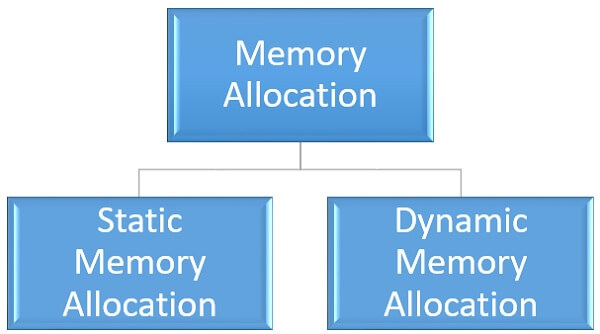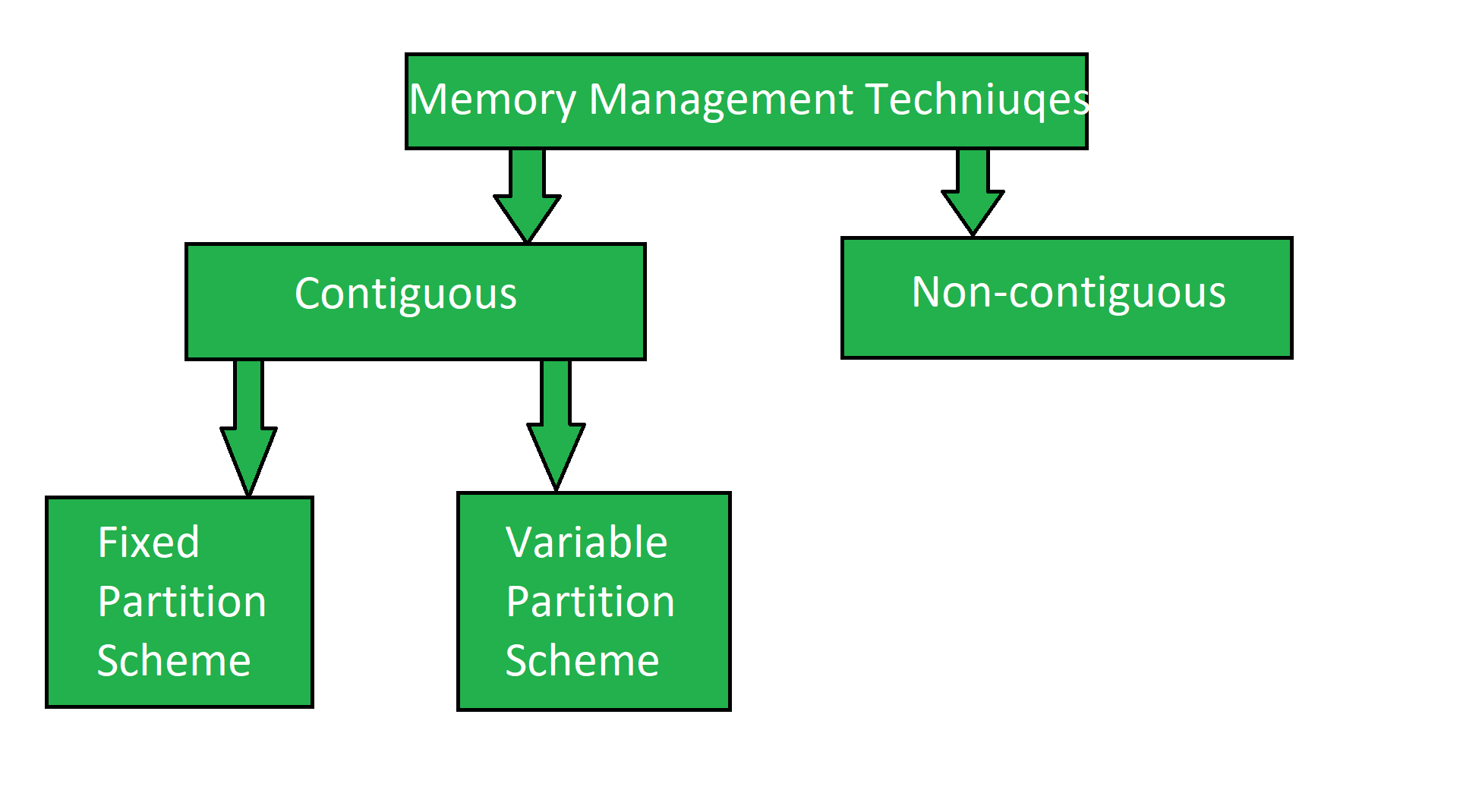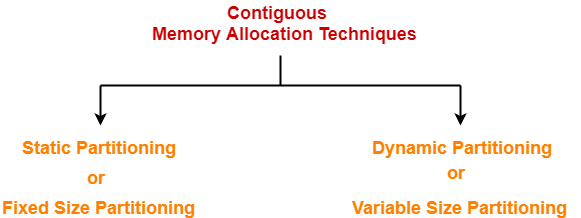Limitation on the size of the process. With the help of the allocation method we can utilize the disk and also files can be accessed.

What Is Memory Allocation In Operating System Static And Dynamic Memory Allocation Binary Terms
Here main memory is divided into two types of partitions Low Memory Operating system resides in this type of memory.

. Storage can be allocated freed arbitrarily from an area known as Heap. Malloc function in C The malloc function allocates single block of requested memory. DDR2 DDR3 DDR4 are the available versions of the DRAM each efficient according to their number.
Disadvantages of Fixed-size Partition Scheme. The program is allocated memory at compile time. Memory allocation algorithms are much simpler with fixed size allocations Page-sized fixed allocations in kernel.
Malloc calloc realloc free Before learning above functions lets understand the difference between static memory allocation and dynamic memory allocation. In contiguous memory allocation whenever the processes come into RAM space is allocated to themThese spaces in RAM are divided either on the basis of fixed partitioningthe size of partitions are fixed before the process gets loaded into RAM or dynamic partitioning the size of the partition is decided at the run time according to the size of the process. Contiguous allocation Linked allocation Indexed allocation The main idea behind contiguous allocation methods is to provide Efficient disk space utilization.
There are following methods which can be used for allocation. Exact size and type of memory must be known at compile time. We can further split long-term memory into two main categories.
Suppose the size of the process is lesser than the size of the partition in that case some size of the partition gets. Techniques can all be viewed as operating in the physical memory space. In the first fit algorithm the allocator keeps a list of free blocks known as the free list and on receiving a request for memory scans along the list for the first block that is large enough to satisfy the request.
For example if a. Each method has its advantages and disadvantages. The Dynamic memory allocation enables the C programmers to allocate memory at runtime.
However many of these techniques can also be used to manage virtual memory space. Has free list of pages Pointer to next page stored in the free page itself For some smaller allocations eg PCB kernel uses a slab allocator Object caches for each type size of objects. List and describe the four memory allocation algorithms.
Exact sizes or amounts like the size of an array for example does not have to be known by the compiler in advance. Contiguous Allocation In this scheme each file occupies a contiguous set of blocks on the disk. All the three methods have their own advantages and disadvantages as discussed below.
Application-level dynamic memory allocation using familiar operations such as the malloc call in C or the new operator in C often allocate large blocks from the OS and then subdivide them. The different functions that we used to allocate memory dynamically at run time are. Linked List Allocation In this scheme each file is a linked list of disk blocks which.
Explicit and implicit long-term memory. Explain the five 5 states of a process. Contiguous Memory allocation.
Memory allocation is the process of setting aside sections of memory in a program to be used to store variables and instances of structures and classes. Mainly a system uses one method for all files within the system. Contiguous allocation requires that each file occupy a set of contiguous blocks on the disk.
Memory Management Techniques in Operating System 1 Segmentation Segmentation refers to the technique of dividing the physical memory space into multiple blocks. Calloc in C is a contiguous memory allocation function that allocates multiple memory blocks at a time initialized to 0. Compile-time or Static allocation.
Now lets have a quick look at the methods used for dynamic memory allocation. There are mainly three methods of file allocation in the disk. If in a case size of a process is more than that of a.
Memory allocation has two core types. There are various types of file allocations method. Heap Storage Allocation It enables the allocation of memory in a Non-nested design.
Allocation method provides a way in which the disk will be utilized and the files will be accessed. Once the program has finished its operation or is idle the memory is released and allocated to another program or merged within the primary memory. Calloc allocating continuous blocks of memory at run time.
High Memory User processes are held in high memory. A Dispatcher b CPU Scheduler c Context Switching d Cache Memory e Deadlock Question 2. Explicit Long-term Memory Explicit long-term memories are memories we consciously and deliberately took time to form and recall.
Memory partitioning is the system by which the memory of a computer system is divided into sections for use by the resident programs. 5 marks An operating system kernel that allows multi-tasking needs processes to have five 5 states. There are two types of memory allocation.
Memory Addressing can be done using pointers index Registers. 2 Dynamic memory allocation -- memory allocated during run time. Contiguous allocation Extents Linked allocation Clustering FAT Indexed allocation Linked Indexed allocation Multilevel Indexed allocation Inode.
Compile-time or Static allocation. There are three methods of file allocation. Malloc allocates a block of memory in bytes at runtime.
Now before We start memory management let us known about what is main memory. 2 Paging Paging is a technique in which the main memory of computer system is organized in the form of equal sized. Each process is allocated according to the requirement.
Partition Allocation Memory is divided into different blocks or partitions. These techniques can often be used in combination. 1 Static memory allocation -- allocated by the compiler.
Run-time or Dynamic allocation using pointers. These memory divisions are known as partitions. There are two types of memory allocations possible in C.
Two types of RAM are. Realloc in C is used to reallocate memory according. Explicit memory holds information such as your best friends birthday or your phone number.
DRAM Dynamic RAM is the commonly used RAM in the computers. The programs are allocated with memory at run time. Heap Allocation is helpful for executing data whose size varies as the program is running.
Unlike earlier times when the computers used to use single data rate SDR RAM now they use dual data rate DDR RAM which has faster processing ability. Malloc in C is a dynamic memory allocation function which stands for memory allocation that blocks of memory with the specific size initialized to a garbage value. The word contiguous means continuous.

Contiguous Memory Allocation Static Partitioning Gate Vidyalay

Memory Management Techniques In Operating System Engineer S Portal

Implementation Of Contiguous Memory Management Techniques Geeksforgeeks
0 Comments